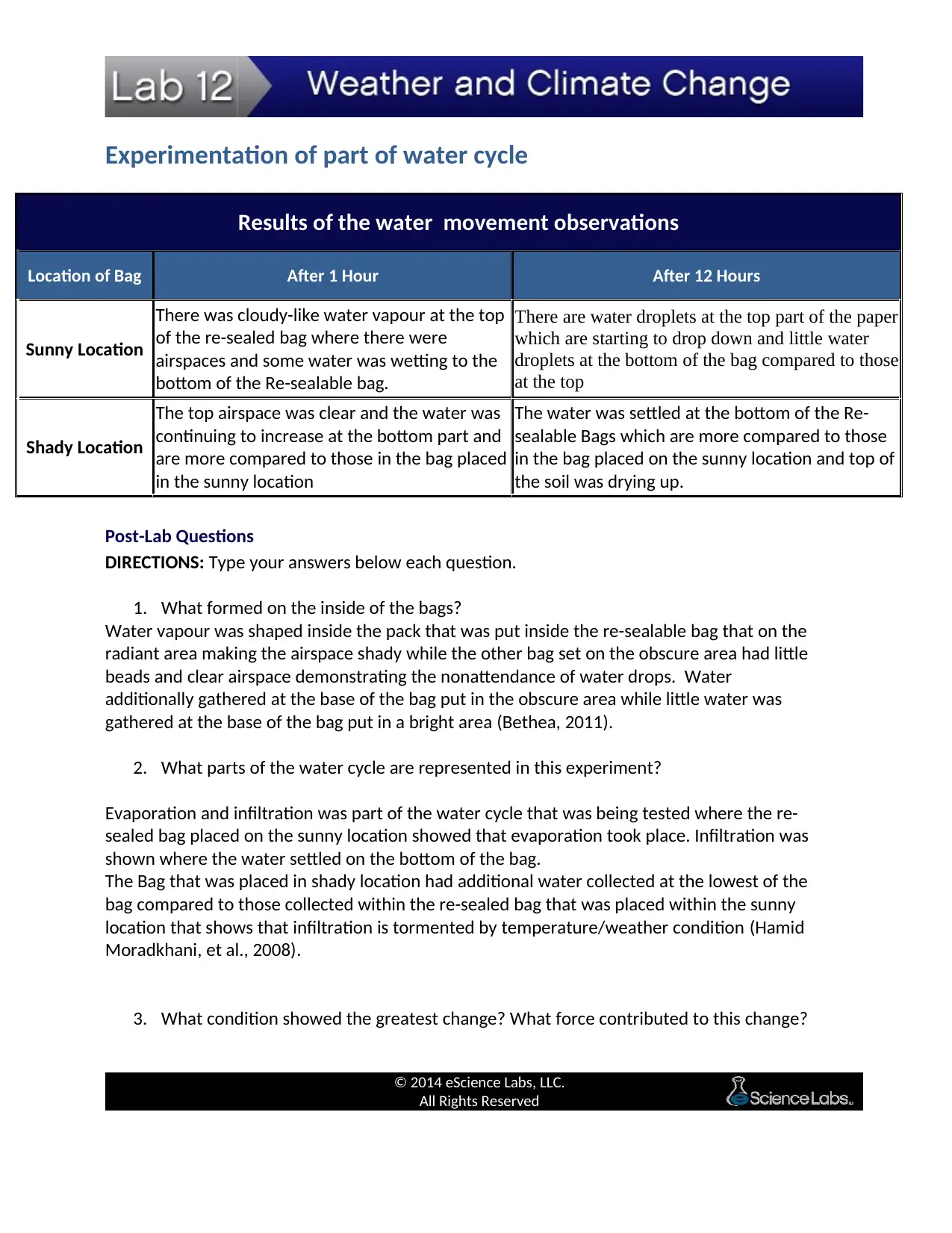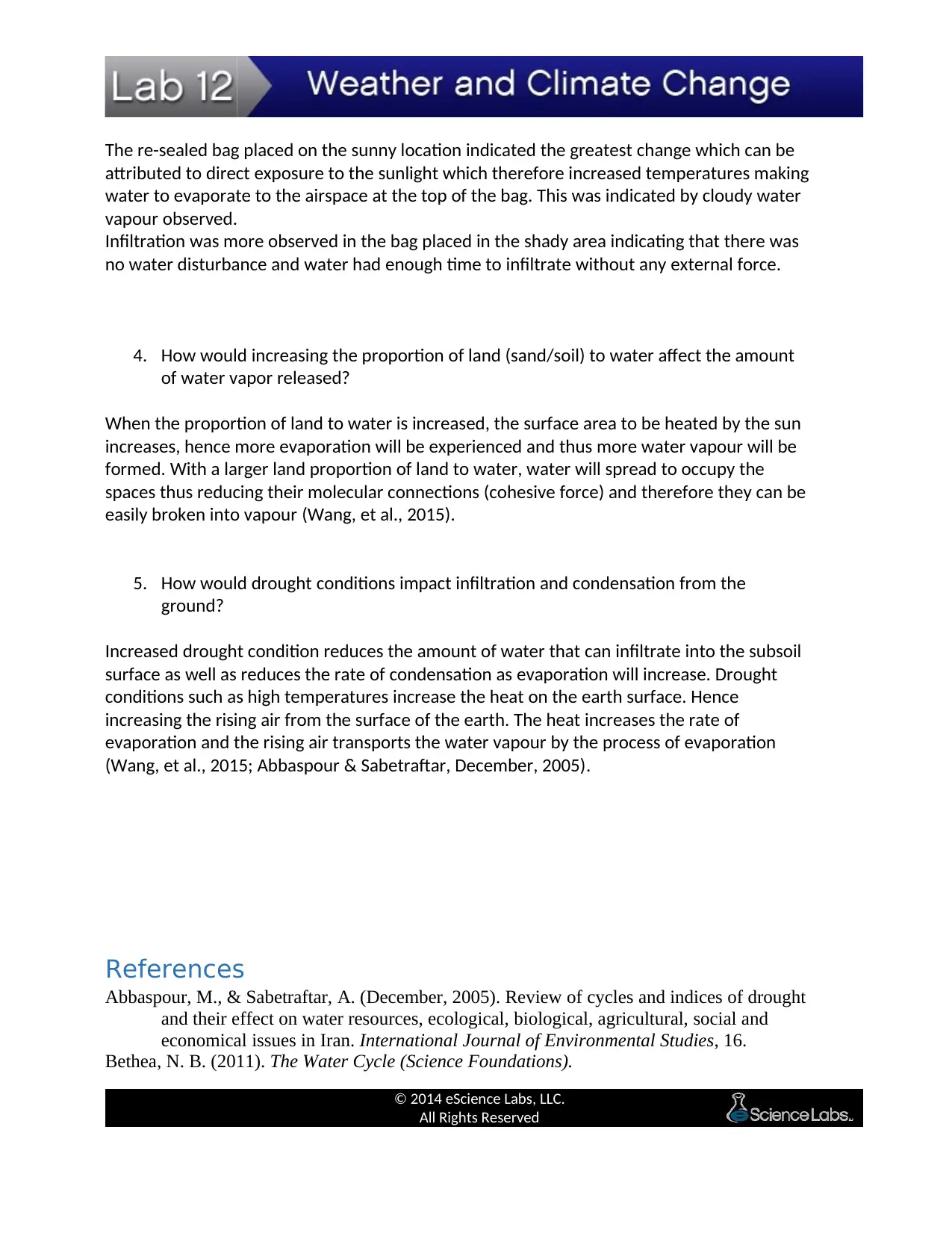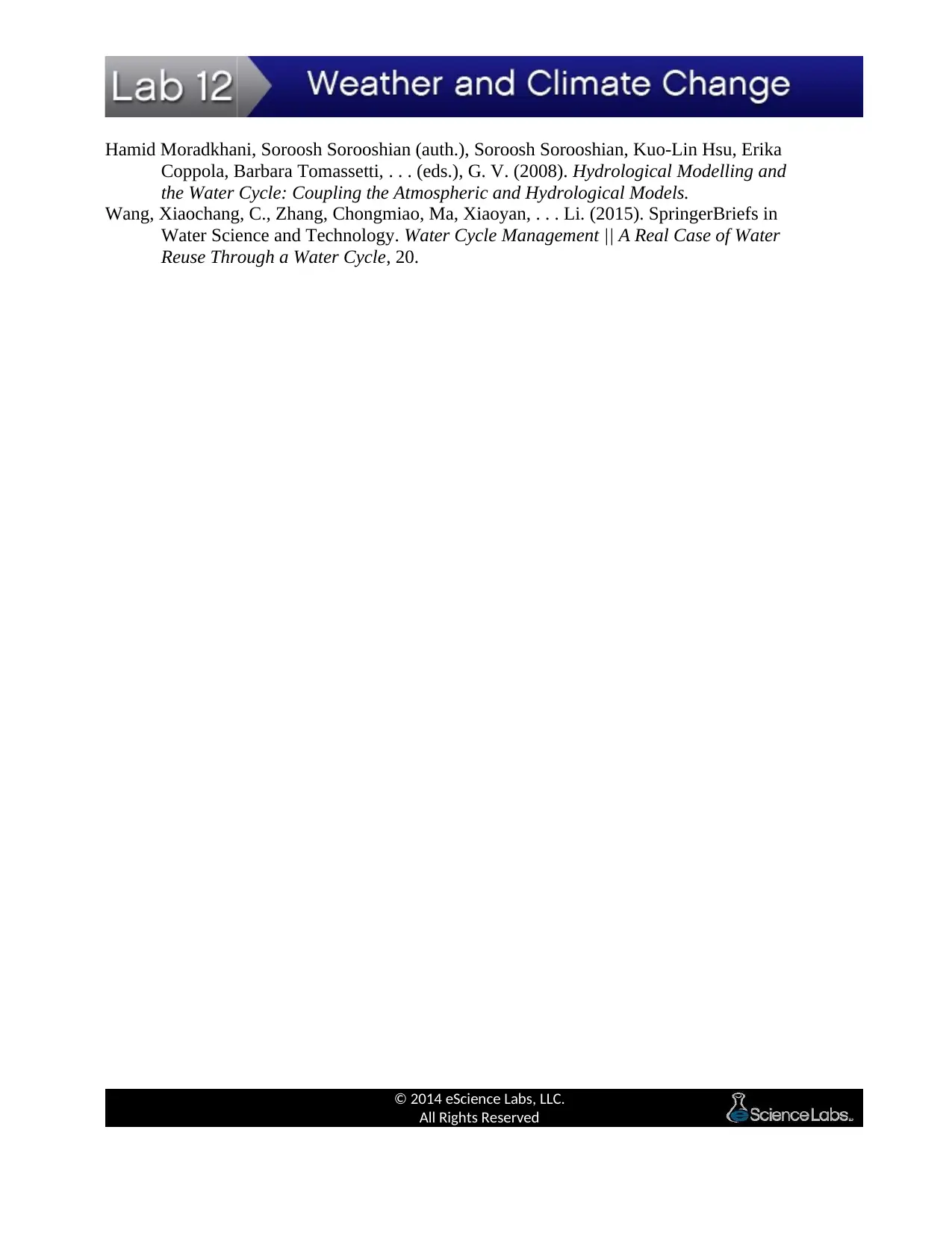Experimentation of Part of Water Cycle Results and Observations
VerifiedAdded on 2023/05/30
|3
|839
|384
AI Summary
Observations and results of an experiment on a part of the water cycle, including evaporation and infiltration, and their impact on water movement. Post-lab questions answered.
Contribute Materials
Your contribution can guide someone’s learning journey. Share your
documents today.

Experimentation of part of water cycle
Results of the water movement observations
Location of Bag After 1 Hour After 12 Hours
Sunny Location
There was cloudy-like water vapour at the top
of the re-sealed bag where there were
airspaces and some water was wetting to the
bottom of the Re-sealable bag.
There are water droplets at the top part of the paper
which are starting to drop down and little water
droplets at the bottom of the bag compared to those
at the top
Shady Location
The top airspace was clear and the water was
continuing to increase at the bottom part and
are more compared to those in the bag placed
in the sunny location
The water was settled at the bottom of the Re-
sealable Bags which are more compared to those
in the bag placed on the sunny location and top of
the soil was drying up.
Post-Lab Questions
DIRECTIONS: Type your answers below each question.
1. What formed on the inside of the bags?
Water vapour was shaped inside the pack that was put inside the re-sealable bag that on the
radiant area making the airspace shady while the other bag set on the obscure area had little
beads and clear airspace demonstrating the nonattendance of water drops. Water
additionally gathered at the base of the bag put in the obscure area while little water was
gathered at the base of the bag put in a bright area (Bethea, 2011).
2. What parts of the water cycle are represented in this experiment?
Evaporation and infiltration was part of the water cycle that was being tested where the re-
sealed bag placed on the sunny location showed that evaporation took place. Infiltration was
shown where the water settled on the bottom of the bag.
The Bag that was placed in shady location had additional water collected at the lowest of the
bag compared to those collected within the re-sealed bag that was placed within the sunny
location that shows that infiltration is tormented by temperature/weather condition (Hamid
Moradkhani, et al., 2008).
3. What condition showed the greatest change? What force contributed to this change?
© 2014 eScience Labs, LLC.
All Rights Reserved
Results of the water movement observations
Location of Bag After 1 Hour After 12 Hours
Sunny Location
There was cloudy-like water vapour at the top
of the re-sealed bag where there were
airspaces and some water was wetting to the
bottom of the Re-sealable bag.
There are water droplets at the top part of the paper
which are starting to drop down and little water
droplets at the bottom of the bag compared to those
at the top
Shady Location
The top airspace was clear and the water was
continuing to increase at the bottom part and
are more compared to those in the bag placed
in the sunny location
The water was settled at the bottom of the Re-
sealable Bags which are more compared to those
in the bag placed on the sunny location and top of
the soil was drying up.
Post-Lab Questions
DIRECTIONS: Type your answers below each question.
1. What formed on the inside of the bags?
Water vapour was shaped inside the pack that was put inside the re-sealable bag that on the
radiant area making the airspace shady while the other bag set on the obscure area had little
beads and clear airspace demonstrating the nonattendance of water drops. Water
additionally gathered at the base of the bag put in the obscure area while little water was
gathered at the base of the bag put in a bright area (Bethea, 2011).
2. What parts of the water cycle are represented in this experiment?
Evaporation and infiltration was part of the water cycle that was being tested where the re-
sealed bag placed on the sunny location showed that evaporation took place. Infiltration was
shown where the water settled on the bottom of the bag.
The Bag that was placed in shady location had additional water collected at the lowest of the
bag compared to those collected within the re-sealed bag that was placed within the sunny
location that shows that infiltration is tormented by temperature/weather condition (Hamid
Moradkhani, et al., 2008).
3. What condition showed the greatest change? What force contributed to this change?
© 2014 eScience Labs, LLC.
All Rights Reserved
Secure Best Marks with AI Grader
Need help grading? Try our AI Grader for instant feedback on your assignments.

The re-sealed bag placed on the sunny location indicated the greatest change which can be
attributed to direct exposure to the sunlight which therefore increased temperatures making
water to evaporate to the airspace at the top of the bag. This was indicated by cloudy water
vapour observed.
Infiltration was more observed in the bag placed in the shady area indicating that there was
no water disturbance and water had enough time to infiltrate without any external force.
4. How would increasing the proportion of land (sand/soil) to water affect the amount
of water vapor released?
When the proportion of land to water is increased, the surface area to be heated by the sun
increases, hence more evaporation will be experienced and thus more water vapour will be
formed. With a larger land proportion of land to water, water will spread to occupy the
spaces thus reducing their molecular connections (cohesive force) and therefore they can be
easily broken into vapour (Wang, et al., 2015).
5. How would drought conditions impact infiltration and condensation from the
ground?
Increased drought condition reduces the amount of water that can infiltrate into the subsoil
surface as well as reduces the rate of condensation as evaporation will increase. Drought
conditions such as high temperatures increase the heat on the earth surface. Hence
increasing the rising air from the surface of the earth. The heat increases the rate of
evaporation and the rising air transports the water vapour by the process of evaporation
(Wang, et al., 2015; Abbaspour & Sabetraftar, December, 2005).
References
Abbaspour, M., & Sabetraftar, A. (December, 2005). Review of cycles and indices of drought
and their effect on water resources, ecological, biological, agricultural, social and
economical issues in Iran. International Journal of Environmental Studies, 16.
Bethea, N. B. (2011). The Water Cycle (Science Foundations).
© 2014 eScience Labs, LLC.
All Rights Reserved
attributed to direct exposure to the sunlight which therefore increased temperatures making
water to evaporate to the airspace at the top of the bag. This was indicated by cloudy water
vapour observed.
Infiltration was more observed in the bag placed in the shady area indicating that there was
no water disturbance and water had enough time to infiltrate without any external force.
4. How would increasing the proportion of land (sand/soil) to water affect the amount
of water vapor released?
When the proportion of land to water is increased, the surface area to be heated by the sun
increases, hence more evaporation will be experienced and thus more water vapour will be
formed. With a larger land proportion of land to water, water will spread to occupy the
spaces thus reducing their molecular connections (cohesive force) and therefore they can be
easily broken into vapour (Wang, et al., 2015).
5. How would drought conditions impact infiltration and condensation from the
ground?
Increased drought condition reduces the amount of water that can infiltrate into the subsoil
surface as well as reduces the rate of condensation as evaporation will increase. Drought
conditions such as high temperatures increase the heat on the earth surface. Hence
increasing the rising air from the surface of the earth. The heat increases the rate of
evaporation and the rising air transports the water vapour by the process of evaporation
(Wang, et al., 2015; Abbaspour & Sabetraftar, December, 2005).
References
Abbaspour, M., & Sabetraftar, A. (December, 2005). Review of cycles and indices of drought
and their effect on water resources, ecological, biological, agricultural, social and
economical issues in Iran. International Journal of Environmental Studies, 16.
Bethea, N. B. (2011). The Water Cycle (Science Foundations).
© 2014 eScience Labs, LLC.
All Rights Reserved

Hamid Moradkhani, Soroosh Sorooshian (auth.), Soroosh Sorooshian, Kuo-Lin Hsu, Erika
Coppola, Barbara Tomassetti, . . . (eds.), G. V. (2008). Hydrological Modelling and
the Water Cycle: Coupling the Atmospheric and Hydrological Models.
Wang, Xiaochang, C., Zhang, Chongmiao, Ma, Xiaoyan, . . . Li. (2015). SpringerBriefs in
Water Science and Technology. Water Cycle Management || A Real Case of Water
Reuse Through a Water Cycle, 20.
© 2014 eScience Labs, LLC.
All Rights Reserved
Coppola, Barbara Tomassetti, . . . (eds.), G. V. (2008). Hydrological Modelling and
the Water Cycle: Coupling the Atmospheric and Hydrological Models.
Wang, Xiaochang, C., Zhang, Chongmiao, Ma, Xiaoyan, . . . Li. (2015). SpringerBriefs in
Water Science and Technology. Water Cycle Management || A Real Case of Water
Reuse Through a Water Cycle, 20.
© 2014 eScience Labs, LLC.
All Rights Reserved
1 out of 3
Your All-in-One AI-Powered Toolkit for Academic Success.
+13062052269
info@desklib.com
Available 24*7 on WhatsApp / Email
![[object Object]](/_next/static/media/star-bottom.7253800d.svg)
Unlock your academic potential
© 2024 | Zucol Services PVT LTD | All rights reserved.